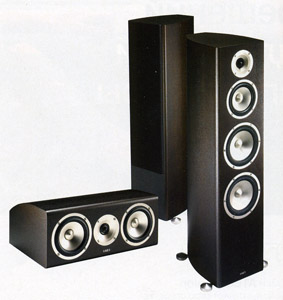The design of the new products took three years. During this time, engineers revised all their previous concepts, striving to find the best solutions and at the same time stay within the middle price segment. James Luce, brand manager of Acoustic Energy, at a presentation at the Moscow showroom "Panorama" said what came of it all.
The Radiance series includes two types of floor standing loudspeakers, bookshelf speakers, center speakers, and subwoofer. The loudspeaker indices are easy to understand: Radiance 1 - one mid / low-frequency emitter, Radiance 2 - a pair in the middle and lower spectrum, finally, Radiance 3 - the largest floor standing speakers with three loudspeakers. These speakers are a source of special pride for the developers. The diffuser is made of metal alloys (AE corporate identity), and its shape has been carefully calculated in order to avoid the bending wave effect and, moreover, to create a strong and rigid piston (no matter how large the diffuser vibration amplitude, it does not change its shape ). As you know, the result of the use of metals in the membrane material is resonant "ringing", but in this case, it was possible to shift it to 9 kHz, and this is the area of responsibility of the tweeter.
 |
In previous models, the sound of tweeters was narrowly directed, the full stage appeared in front of the listener only if he was in a strictly defined place. Moreover, if the dispersion of the mid / bass and tweeters is different, it affects the model of the first reflections in the room, significantly increasing phase differences across the frequency spectrum. The new products use DXT acoustic lens technology (Diffraction Expansion Technology). If you look at the area where the tweeter is installed, you will notice that it is recessed inside the spherical surface. In fact, we have an emulation of a horn circuit, but just enough to solve problems regarding uniformity of dispersion.
A further obstacle to better sound is the frequency filter. James Luce described how the firm overcame this obstacle: “If you use aluminum diffusers, the design of a crossover becomes a non-trivial task. Previously, the filter had 14 elements, but the engineers were able to reduce the base to 4 elements, we completely eliminated the resistors, since in our tests they often negatively affected the result. " A simple layout, no unnecessary details that can cause energy loss or distorted sound - a High-End approach.
The Radiance series is mid-priced, especially compared to the top-end Reference, so there was no way to use metal in speaker cabinets to make them heavier. The engineers took a different path and, on the contrary, made the "cabinets" lightweight so that less excessive acoustic energy was retained in them, paying special attention to the legs that should take it away. Internal screeds, non-parallel rigid walls (some of them are rounded), phase inverters with a special pipe opening profile - everything here works to minimize standing waves inside the case and give out only the original sound.
It should be noted, by the way, that the main production facilities of Acoustic Energy are the largest Malaysian company in the acoustic world, which produces speakers for a number of famous brands (it is expensive to make them in the UK, moreover, today some Asian manufactures provide higher quality than European ones). Actually, AE loudspeakers are manufactured there (except for the top series). As James Luce says, usually for this price category, drivers are made with a tolerance (based on measurements of frequency response and impulse response) of 2-3 dB. For more expensive models, the figure can approach 1-1.5 dB. However, Acoustic Energy, given the close relationship of the companies, gets speakers with a tolerance of no more than 0.5 dB.









.jpg)


.jpg)



0 Comments